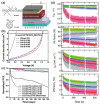Interfacial Materials for Organic Solar Cells: Recent Advances and Perspectives
- PMID: 27812480
- PMCID: PMC5067618
- DOI: 10.1002/advs.201500362
Interfacial Materials for Organic Solar Cells: Recent Advances and Perspectives
Abstract
Organic solar cells (OSCs) have shown great promise as low-cost photovoltaic devices for solar energy conversion over the past decade. Interfacial engineering provides a powerful strategy to enhance efficiency and stability of OSCs. With the rapid advances of interface layer materials and active layer materials, power conversion efficiencies (PCEs) of both single-junction and tandem OSCs have exceeded a landmark value of 10%. This review summarizes the latest advances in interfacial layers for single-junction and tandem OSCs. Electron or hole transporting materials, including metal oxides, polymers/small-molecules, metals and metal salts/complexes, carbon-based materials, organic-inorganic hybrids/composites, and other emerging materials, are systemically presented as cathode and anode interface layers for high performance OSCs. Meanwhile, incorporating these electron-transporting and hole-transporting layer materials as building blocks, a variety of interconnecting layers for conventional or inverted tandem OSCs are comprehensively discussed, along with their functions to bridge the difference between adjacent subcells. By analyzing the structure-property relationships of various interfacial materials, the important design rules for such materials towards high efficiency and stable OSCs are highlighted. Finally, we present a brief summary as well as some perspectives to help researchers understand the current challenges and opportunities in this emerging area of research.
Keywords: energy conversion; interface engineering; interlayers; organic solar cells; semiconductors.
Figures















References
-
- Li G., Zhu R., Yang Y., Nat. Photon. 2012, 6, 153.
-
- Liu M., Johnston M. B., Snaith H. J., Nature 2013, 501, 395. - PubMed
-
- Mathew S., Yella A., Gao P., Humphry‐Baker R., Curchod B. F. E., Ashari‐Astani N., Tavernelli I., Rothlisberger U., Nazeeruddin M. K., Grätzel M., Nat. Chem. 2014, 6, 242. - PubMed
-
- Günes S., Neugebauer H., Sariciftci N. S., Chem. Rev. 2007, 107, 1324. - PubMed
LinkOut - more resources
Full Text Sources
Other Literature Sources
Miscellaneous
